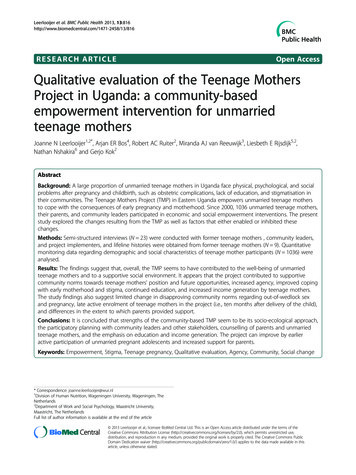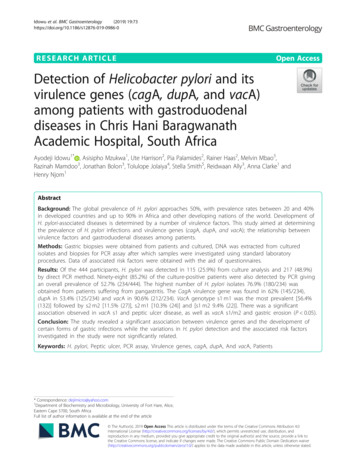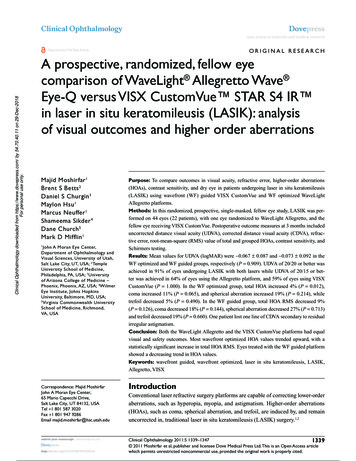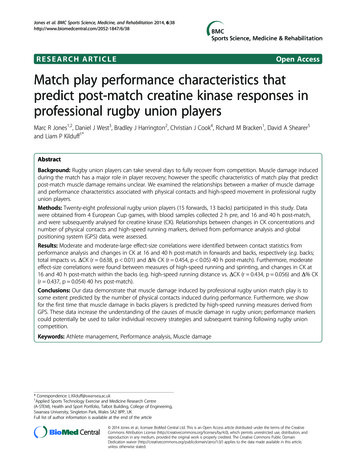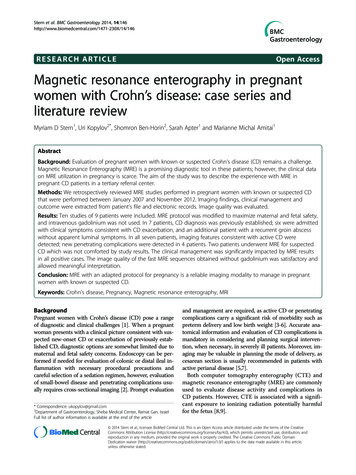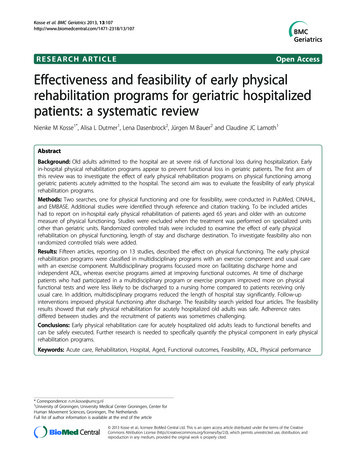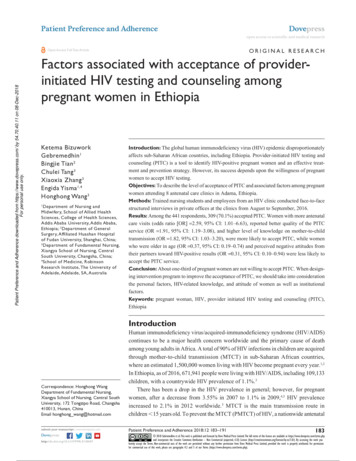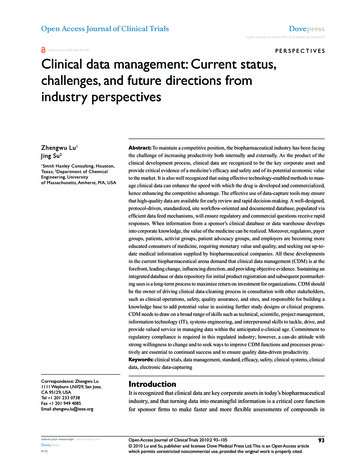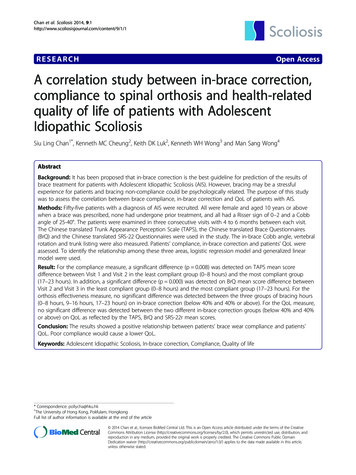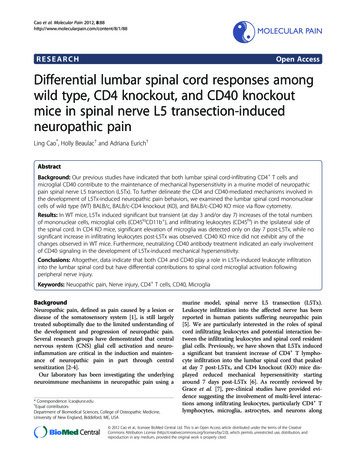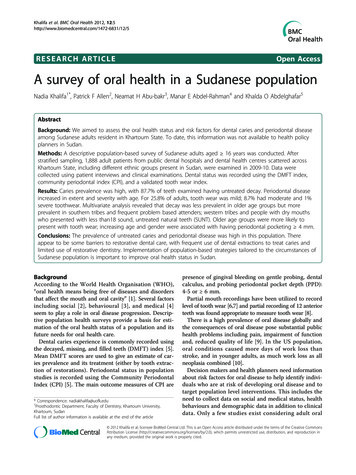
Transcription
Khalifa et al. BMC Oral Health 2012, EARCH ARTICLEOpen AccessA survey of oral health in a Sudanese populationNadia Khalifa1*, Patrick F Allen2, Neamat H Abu-bakr3, Manar E Abdel-Rahman4 and Khalda O Abdelghafar5AbstractBackground: We aimed to assess the oral health status and risk factors for dental caries and periodontal diseaseamong Sudanese adults resident in Khartoum State. To date, this information was not available to health policyplanners in Sudan.Methods: A descriptive population-based survey of Sudanese adults aged 16 years was conducted. Afterstratified sampling, 1,888 adult patients from public dental hospitals and dental health centres scattered acrossKhartoum State, including different ethnic groups present in Sudan, were examined in 2009-10. Data werecollected using patient interviews and clinical examinations. Dental status was recorded using the DMFT index,community periodontal index (CPI), and a validated tooth wear index.Results: Caries prevalence was high, with 87.7% of teeth examined having untreated decay. Periodontal diseaseincreased in extent and severity with age. For 25.8% of adults, tooth wear was mild; 8.7% had moderate and 1%severe toothwear. Multivariate analysis revealed that decay was less prevalent in older age groups but moreprevalent in southern tribes and frequent problem based attenders; western tribes and people with dry mouthswho presented with less than18 sound, untreated natural teeth (SUNT). Older age groups were more likely topresent with tooth wear; increasing age and gender were associated with having periodontal pocketing 4 mm.Conclusions: The prevalence of untreated caries and periodontal disease was high in this population. Thereappear to be some barriers to restorative dental care, with frequent use of dental extractions to treat caries andlimited use of restorative dentistry. Implementation of population-based strategies tailored to the circumstances ofSudanese population is important to improve oral health status in Sudan.BackgroundAccording to the World Health Organisation (WHO),“oral health means being free of diseases and disordersthat affect the mouth and oral cavity” [1]. Several factorsincluding social [2], behavioural [3], and medical [4]seem to play a role in oral disease progression. Descriptive population health surveys provide a basis for estimation of the oral health status of a population and itsfuture needs for oral health care.Dental caries experience is commonly recorded usingthe decayed, missing, and filled teeth (DMFT) index [5].Mean DMFT scores are used to give an estimate of caries prevalence and its treatment (either by tooth extraction of restorations). Periodontal status in populationstudies is recorded using the Community PeriodontalIndex (CPI) [5]. The main outcome measures of CPI are* Correspondence: nadiakhalifa@uofk.edu1Prosthodontic Department, Faculty of Dentistry, Khartoum University,Khartoum, SudanFull list of author information is available at the end of the articlepresence of gingival bleeding on gentle probing, dentalcalculus, and probing periodontal pocket depth (PPD):4-5 or 6 mm.Partial mouth recordings have been utilized to recordlevel of tooth wear [6,7] and partial recording of 12 anteriorteeth was found appropriate to measure tooth wear [8].There is a high prevalence of oral disease globally andthe consequences of oral disease pose substantial publichealth problems including pain, impairment of functionand, reduced quality of life [9]. In the US population,oral conditions caused more days of work loss thanstroke, and in younger adults, as much work loss as allneoplasia combined [10].Decision makers and health planners need informationabout risk factors for oral disease to help identify individuals who are at risk of developing oral disease and totarget population level interventions. This includes theneed to collect data on social and medical status, healthbehaviours and demographic data in addition to clinicaldata. Only a few studies exist considering adult oral 2012 Khalifa et al; licensee BioMed Central Ltd. This is an Open Access article distributed under the terms of the Creative CommonsAttribution License (http://creativecommons.org/licenses/by/2.0), which permits unrestricted use, distribution, and reproduction inany medium, provided the original work is properly cited.
Khalifa et al. BMC Oral Health 2012, lth in sub-Saharan Africa [11-16]. Findings of thesestudies suggest that the prevalence of dental disease isgenerally low in African populations, and that limitedaccess to dental services leads to retention of cariousteeth.There is a relative lack of data pertaining to adults inthe developing world in general and in Sudan in particular. Most of the studies focused on school children orused small samples.The aim of this study was to assess the oral health status and associated risk indicators for oral disease inSudanese adults attending outpatient clinics in Khartoum State.MethodsStudy designThis cross-sectional oral health survey was part of a studydesigned to assess the functional and psychosocial impactof dental disease and was carried out between August 2009and March 2010. The study participants were recruitedfrom among those attending outpatient dental hospitalsand health centers distributed among the seven provinces(Um Durman, Khartoum Bahri, Khartoum, Jabal Aulia,Sharg En Nile, Karary, and Um badda) of Khartoum State.Sudan was the largest country in Africa before SouthSudan became an independent country on 9 July 2011. Itwas divided into 25 states, with Khartoum State the capitalbeing the most densely populated state (Figure 1). Thestudy population comprised 1,888 patients. The samplesize was calculated using the formula for proportion estimates considering a tooth loss prevalence of 67% accordingto previous Sudanese studies [17,18] and precision of 3; thedesign effect was set as 2. The sampling frame for thestudy was the public dental service in Sudan. There are 3levels (federal, state, and locality) of health care systems inKhartoum. All the dental outpatient clinics of these facilities were included in the sampling frame. The sample sizeof each outpatient clinic was obtained by the followingequation: nh (Nh/N)*n; where nh was the sample size ofeach outpatient clinic h, Nh the population size (no. outpatients/3 months of the specific hospital/dental health center[DHC]) for stratum h, N the total population size (total no.outpatients/3 months of all hospitals and DHC), and ntotal sample size (1,888) (Table 1). Patients were selectedconsecutively until the required number of patients fromthe different hospitals and DHCs were obtained. Writtenconsent was obtained from all patients. The study protocolwas approved by the National Ethical Clearance Committee of the Federal Ministry of Health in Khartoum, Sudan.Data collectionSocio-demographic variables included age, gender, ethnic group, and socioeconomic status (occupation, totalmonthly income, education).Page 2 of 9Behavioural variables included frequency and reasonfor dental visits, if applicable number of teeth removedat final visit, tobacco use and way of consumption, aswell as frequency and method used for dental hygiene.Because of the developing interest in the relationshipbetween oral and general health, it was considerednecessary to try to establish some of the main medicalcharacteristics of the population sample through questions such as use of medication, previous surgery anddetails of diagnosed medical conditions. Participantswere also asked “How often does your mouth feel dry?”with response options “always”, “frequently”, “occasionally”, or “never”. At the analysis stage, those who hadresponded “always” or “frequently” were designated asxerostomic.Data were collected using a questionnaire administered in interviews by researchers not involved in thetreatment of the patients. The interviews took 15-20minutes prior to the clinical examinations.Clinical examinations were undertaken by five calibrated dentists, including the lead author. Following aperiod of training in clinical examination proceduresand calibration, inter-examiner reliability was checkedusing intra-class correlation coefficients (ICC). Interexaminer reliability was assessed in 20 patients at thebeginning of the survey, and during the survey. Fieldchecks were also carried out during the survey by themain investigator who also acted as gold standard.Inter-examiner reliability was assessed by intra-classcorrelation coefficient (ICC) on clinical measures ofCPI, DMFT, and tooth wear at 2-3 weeks apart. ICC forCPI, DMFT, and tooth wear the before start of surveywas 0.67 (95%CI, 0.56-0.83), 0.96 (95%CI, 0.92-0.97),and 0.55 (95% CI, 0.41-0.75), respectively, and duringthe survey was 0.61 (95% CI, 0.55-0.68), 0.85 (95% CI,0.81-0.87), and 0.59 (95%CI, 0.49-0.62), respectively.Thus, according to Fleiss [19], ICC for CPI ranged fromfair to good, for DMFT excellent, and for tooth wearfair to good.Once a satisfactory level of examiner reliability wasestablished, clinical examinations were undertaken usingWHO criteria for population oral health surveys.DMFT was used to obtain estimates of how much thedentition was affected by dental caries. The clinicalexamination included a full mouth recording for 32 teeth[5]. Decay was recorded if a carious cavity was visuallypresent and a CPI probe was used to confirm visual evidence of caries. A tooth was recorded as missing due tocaries if there was a history of extraction because of thepresence of a cavity prior to extraction. Periodontalhealth was assessed by CPI [5]. The three indicators usedfor this assessment were gingival bleeding, calculus, andperiodontal pockets. A specially designed lightweightWHO CPI probe was used to record clinical data by
Khalifa et al. BMC Oral Health 2012, e 3 of 9Figure 1 Map of Sudan.sextant, and coded as 0 (no disease), 1 (gingival bleedingdetected), 2 (calculus detected), 3 (pockets 5.5 mm) or4 (pockets of 6 mm)The 12 upper and lower anterior teeth were examinedfor toothwear. The index used was that used in the survey of Oral Health in Irish Adults 2000-02 [20] and theAdult Dental Health Survey in the United Kingdom in1998 [7]. It was a descriptive index using partial recording of the labial, incisal, and palatal surfaces of theupper six permanent anterior teeth. On the upper incisalsurfaces, wear typical of erosion was scored if present.The condition of the most worn surface of the lower sixpermanent anterior teeth was recorded. Wear wasrecorded when it had progressed through tooth enamelinto the dentine because considerable inter-examinervariability has been reported when trying to record wearconfined to tooth enamel.Tooth wear was classified as “mild” (tooth wear justexposing the dentine), “moderate” (tooth wear exposingthe dentine for more than one third of the individualsurface), or “severe” (complete loss of tooth enamel,with the pulp or secondary dentine exposed).
Khalifa et al. BMC Oral Health 2012, e 4 of 9Table 1 Proportional sample size calculation of hospital/dental centerHNhKhartoum Teaching Dental Hospital21,000nh343Umdurman Dental Hospital23,275382Bahrey Dental Hospital13,046211Police Dental Hospital24,500400Military Dental Hospital19,784323Dental Health Centers14,025229115,632 N1,888 nAll data were recorded on standardized proformae andentered into a spreadsheet for analysis. Random checking was undertaken to verify the accuracy of data entry.Data analysesAnalyses were performed using the statistical softwarepackage STATA Release 9 (Stata Statistical Software 2005;StataCorp LP, College Station, TX, USA). Summary datawere reported using frequency distributions. The categorical-dependent or outcome variables were reduced to binary variables such as: 18 and 18 sound untreatednatural teeth (SUNT); zero decayed teeth (DT) and 1DT; no tooth wear and tooth wear; healthy periodontal tissues and those with periodontal pockets 4 mm. Bivariateanalysis of these data was undertaken using Pearson’s chisquare tests. The independent factors used in these analyses included sociodemographic such as sex, age group,ethnic group, occupation, monthly household income, andeducation level achieved; behaviours such as frequency ofdental visits, tobacco use, and frequency and type of dentalhygiene and,; medical, such as how often mouth feels dry,history of surgery, and, current medical status. Multivariate logistic regression modeling was used to ensure allowance for potential confounding variables.ResultsSociodemographic, behavioral, and medicalcharacteristicsThe number of adults examined was 1,888 split intoseven age groups “see Additional file 1“. According totheir ethnic group, most probands (57%) came fromnorthern and central tribes followed by western tribes(33.7%). For nearly three quarters of subjects, the headof household had an income of 250 SDG ( 75 Euromonthly); 25.8% never went to school or only went tokhawla, a type of kindergarten, with 20% completingonly primary school and 60% having semiskilled orunskilled jobs.Over sixty percent of subjects went to the dentist lessfrequently than every 2 years, 16.7% went more frequently than every 2 years, and 22.7% never went,indicating poor attendance. Only 9% went for regularcheckups whereas 91% of patients only went to thedentist when they were in pain.In terms of treatment received during the most recentdental visit, more than 55% of people had a single toothextraction as their only treatment. When asked aboutthe reason for extraction, nearly 80% stated that thiswas the advice given by the dentist.Tobacco use was prevalent in approximately 17%. ofthe sample. Besides cigarette smoking (62%), the use ofsmokeless tobacco, locally known as toombak, wasreported in 51% of the sample.In terms of dental hygiene behaviours only, 53%reported that they brushed their teeth twice daily. Additional methods of oral hygiene such as use of a mouthrinse (11%) and inter-dental cleaning (3%) were rarelyused.Of the people who reported medical problems (17%),27% had hypertension and 17% diabetes mellitus. Thiswas also reflected in similar pattern by people on medication (14%) among whom 21% were on antihypertensive and 14.6% on antidiabetic medications. The feelingof dry mouth was assessed using a validated xerostomia index [20]. In response to the question “Howoften does your mouth feel dry?” (response options:always, frequently, occasionally, or never), those whohad responded with “always” or “frequently” weredesignated as xerostomic. Nearly one fifth (19.3%) ofparticipants reported that their mouth felt dry occasionally or more frequently, with 3.5% to the point ofbeing xerostomic.Frequencies of clinical findings: CPI, DMFT, tooth wearIn the 35-44 age group 36.1% had healthy periodontaltissues, 10.9% bleeding, 42.0% calculus, 8.5% 4-5-mmperiodontal pocketing, 0.7% periodontal pocketing of 6 mm, and 1.8% excluded sextants (Figure 2).The mean DMFT for age group 35-44 years was 8.7(SD, 5.9) (Table 2). The overall mean number of missingteeth was 3.6 (SD, 4.9) and in the age group 35-44 yearswas 4.2 (SD, 4.1). Surprisingly, the mean number ofteeth was high 28.4 (SD, 4.9); however, percent DT was87%. Even though teeth existed, they were badly decayeddue to lack of treatment. This was substantiated by thefinding that the filled component of DMFT was 0.2%.The prevalence of root caries in adults aged 16 yearson exposed teeth was 23.6%. Root caries was more prevalent with increasing age.More than one third (35.5%) of adults had somedegree of wear of their anterior teeth that involved atleast some dentine. In 25.8% of adults the wear wasmild; 8.7% had moderate and 1% severe wear. Mildtooth wear decreased with age whereas moderate andsevere increased with age.
Khalifa et al. BMC Oral Health 2012, e 5 of 9Figure 2 Distribution of adults according to periodontal conditions.that should be considered when interpreting the datapresented in this study. Given the available infrastructure, it is not possible to conduct a randomly selectedsample representative of the entire Sudanese population.Whereas it is possible to obtain some information onoral health issues from patients attending outpatientfacilities of hospitals and dental health centres of Khartoum State, the findings may not be representative ofthe whole of Sudan. The sample was biased in that visitsby the individuals attending these clinics were problembased. However, the sampling strategy employed ensuresthat the sample recruited from the country’s most populated state is broadly representative of Sudan. Given thelimited infrastructure for oral health services delivery inKhartoum, the prevalence rates of conditions reportedin this paper are unlikely to be overestimated. Manypeople in Sudan do not receive regular dental care andhave acute problems when seen by a dentist. In Sudanthe dentist-to-patient ratio is 1:33,000 compared withapproximately 1:2,000 in most industrialized countries[21]. Relative to the size of the Sudanese population,there are very few dentists and this restricts access toregular dental care. Other factors which influence dentalattendance in Sudan include the lack of public fundingfor oral healthcare and dental insurance schemes toMultivariate logistic regression analysisIndependent factors found significant by Pearson’s chisquare analysis were all entered in one step, into fourseparate multivariate logistic regression models, investigating the likelihood of having decay, 18 SUNT, toothwear, and periodontal pockets 4 mm. Details of variables with increased/decreased odds of predicting oraldisease are presented “see Additional file 1“, with R 2values showing how much variation can be explained byeach model. The multivariate logistic regression analysisrevealed that presence of decay seemed less prevalent inolder than younger age groups. Those who were educated, went for checkups, and cleaned between teethhad a decreased likelihood of having dental decay. Western tribes (OR, 1.83) as well as those with occasionaldry mouth (OR, 2.18) were more likely to present with 18 SUNT.As expected, older age groups presented more toothwear than younger age groups. In terms of periodontaldisease, increasing age and being a male were characteristics associated with periodontal pocketing 4 mm.DiscussionThis study is the first large population based study ofadult oral health in Sudan. There were some limitationsTable 2 Mean DMFT according to age groupAge groupNMeanDMFTStd. DeviationStd. Error of 9)11.3(7.9)0.2(0.6)75 3.5(3.2)3.6(4.9)0.2(0.8)
Khalifa et al. BMC Oral Health 2012, liorate the cost of care. In that sense, the dentalattendance experience of this sample is not untypical ofthe wider Sudanese context.One of the most striking findings from the study isthe apparent lack of restorative or preventive dentalcare, as shown by the filled component F (0.2%) andtreatment is limited to pain relief or emergency care bytooth extraction. Dentists’ attitudes toward dental treatment were shown greatly to influence tooth extractionsin this study. It would appear that there are barriers tothe provision of restorative dental care which are multifactorial in origin and worthy of further investigation.There were relatively few participants aged 65 years,but this reflects the age distribution of the Sudanesepopula
nic group, and socioeconomic status (occupation, total monthly income, education). Behavioural variables included frequency and reason for dental visits, if applicable number of teeth removed at final visit, tobacco use and way of consumption, as well as frequency and method used for dental
